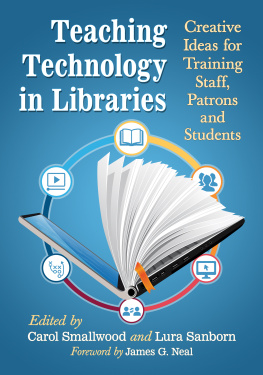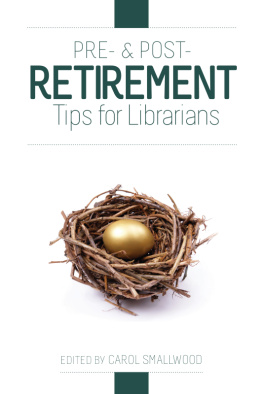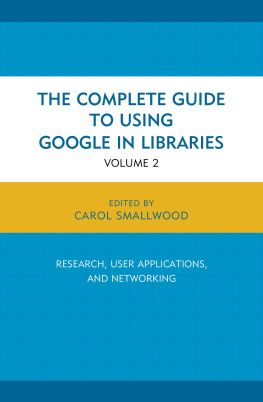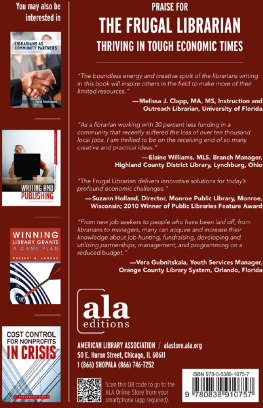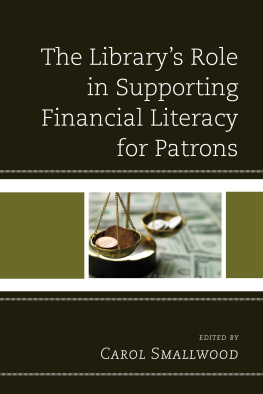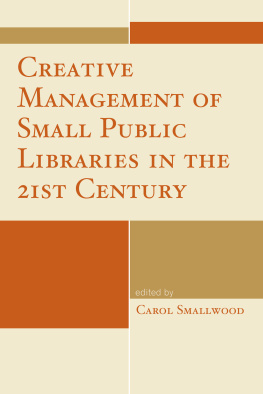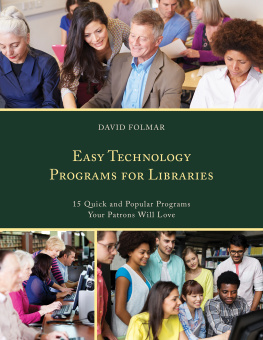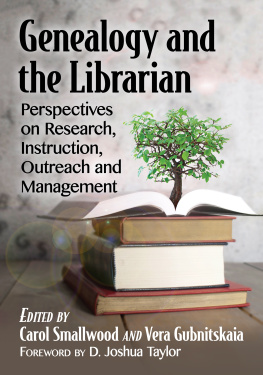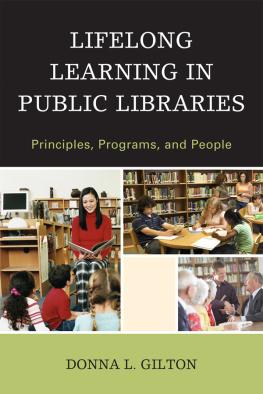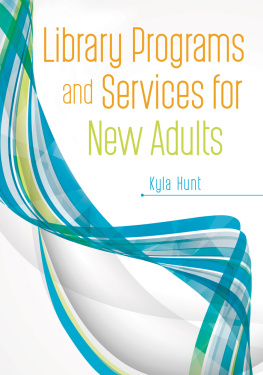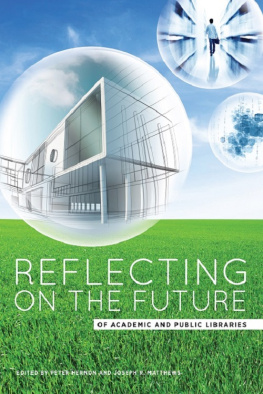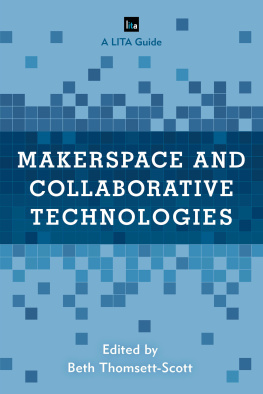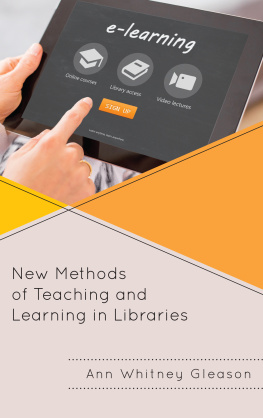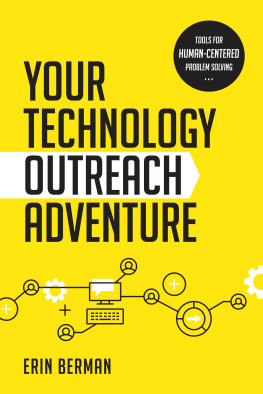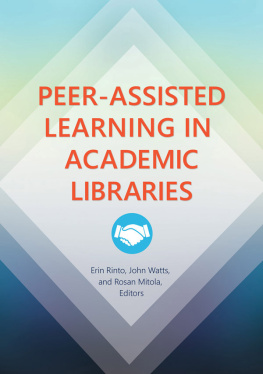
Teaching Technology in Libraries
Creative Ideas for Training Staff, Patrons and Students
EDITED BY
CAROL SMALLWOOD and LURA SANBORN
Foreword by James G. Neal

McFarland & Company, Inc., Publishers
Jefferson, North Carolina
RECENT MCFARLAND WORKS FROM CAROL SMALLWOOD (WITH OTHERS)
Library Partnerships with Writers and Poets: Case Studies, edited by Carol Smallwood and Vera Gubnitskaia (2017); Library Volunteers Welcome!: Strategies for Attracting, Retaining and Making the Most of Willing Helpers,edited by Carol Smallwood and Lura Sanborn (2016); Continuing Education for Librarians: Essays on Career Improvement Through Classes, Workshops, Conferences and More, edited by Carol Smallwood, Kerol Harrod and Vera Gubnitskaia (2013); Marketing Your Library: Tips and Tools That Work, edited by Carol Smallwood, Vera Gubnitskaia and Kerol Harrod (2012); Mentoring in Librarianship: Essays on Working with Adults and Students to Further the Profession, edited by Carol Smallwood and Rebecca Tolley-Stokes (2012); Women on Poetry: Writing, Revising, Publishing and Teaching, edited by Carol Smallwood, Colleen S. Harris and Cynthia Brackett-Vincent (2012); Thinking Outside the Book: Essays for Innovative Librarians, edited by Carol Smallwood (2008); Internet Sources on Each U.S. State: Selected Sites for Classroom and Library, compiled by Carol Smallwood, Brian P. Hudson, Ann Marlow Riedling and Jennifer K. Rotole (2005)
e-ISBN: 978-1-4766-2718-2
LIBRARY OF CONGRESS CATALOGUING DATA ARE AVAILABLE
BRITISH LIBRARY CATALOGUING DATA ARE AVAILABLE
2017 Carol Smallwood and Lura Sanborn. All rights reserved
No part of this book may be reproduced or transmitted in any form or by any means, electronic or mechanical, including photocopying or recording, or by any information storage and retrieval system, without permission in writing from the publisher.
Front cover image of learning concept 2017 Jacek Kita/iStock
McFarland & Company, Inc., Publishers
Box 611, Jefferson, North Carolina 28640
www.mcfarlandpub.com
Foreword
by James G. Neal
User instruction is part of the DNA of libraries. In a field characterized by shifting user expectations and needs, creative service strategies, acceleration in collective innovation, radical collaboration, a focus on assessment and demonstration of value, economic challenges, and constant mutability, librarians and other information professionals play a critical role in educating our users and staff to be successful and productive in their use of technology. Librarianship is buffeted by constant revolutions in technology, in the platforms that support our work and our services, in the need to achieve scale and network effects through aggregation, in the devices that enable access, in the explosion of electronic and born digital content, in the tools that support our work, in the networks that connect us with the world, in the maker initiatives in our libraries, in the growing importance of the personal web, 3-D printing, artificial intelligence and geo-everything. Libraries own the responsibility for teaching and developing new skills and knowledge, for improving capability, productivity and performance.
Carol Smallwood and Lura Sanborn have assembled a remarkable group of accomplished and expert authors providing insightful guidance on technology use instruction in a wide variety of library settings and circumstances. This is an essential primer and guide to creative thinking, best practices, and provocative experiences in training and education. The contributors understand and embrace the limitations of resources, time and personnel in our libraries, and focus on very practical and effective techniques of instruction. We learn through case studies and discussions of methodology, through a focus on empowering front-line staff, through software and coding activities, and through valuable thinking about strategy, planning and collaboration. Across 28 essays, we are treated to rich and very helpful grounding on how to advance technology use instruction.
The 21st century information professional must be committed to continuous personal development. Libraries must sustain a strong service ethic which places user instruction as a core value and strategic priority in all settings. These two drivers are part of the larger context of library transformation: a need to change in composition and structure, that is, what we are and what we do; to change our outward form and appearance, that is, how we are viewed and understood; and to change our character and condition, that is, how we do it. We must be virtual, engaged with our users in new and powerful ways. We must be virtuoso, smart but always ready to learn. And we must be virtuous, always embracing and supporting the public interest, and working to improve the experience of those we serve.
Our users want more and better content, more and better access, convenience, and new capabilities and skills. They want to manage costs and be productive, to control their information environments, and to participate in the use of new technologies. Well-designed and effectively delivered technology use instruction for our patrons, students and staffs is essential to our successful library future. This important compendium of ideas and experiences will help us to even more essential to our communities and to be embraced by both users and decision makers.
James G. Neal is the president-elect of the American Library Association. He will assume the role of president in June 2017. He served as the vice president for information services and university librarian at Columbia University from 2001 to 2014, providing leadership for university academic computing and a system of 22 libraries. Previously, he served as the dean of University Libraries at Indiana University and Johns Hopkins University and held administrative positions in the libraries at Penn State, Notre Dame and the City University of New York.
Preface
Teaching Technology in Libraries is by school, public, and academic librarians in the United States sharing their expertise on teaching the use of technology in their libraries to staff, patrons, and students. In addition to keeping up with technology that advances at a bewildering rate, librarians have the equally challenging task of teaching it to various users when constricted by time, help, and reduced budgets.
The 28 essays written by one to three authors are divided into parts: Part I is Case Studies and Instruction Methodology; Part II is Teaching Staff to Teach Patrons; Part III is Hardware, Software and Code; and Part IV is Strategies, Planning and Partnerships.
Our thanks to James G. Neal, president-elect of the American Library Association for the foreword. Thanks also to Wei Fang, Roland Barksdale-Hall, Vera Gubnitskaia, and Shana Gass for writing back-cover blurbs.
Supporting Student Comprehension through Technology
Scaffolding Techniques in a Virtual Environment
FRANCISCO J. FAJARDO and JORGE E. PEREZ
When one thinks of scaffolding, the image of a building under construction or a support structure comes to mind. These mental pictures are part of foundation of a stand-alone or larger edifice. Similarly, we can apply the concept of scaffolding to education, helping students in learning complex concepts and ideas. Scaffolding supports students in executing difficult tasks and serves both struggling and high-achieving students. By providing scaffolding in a course, instructors are able to fill in the learning gaps while taking on new challenges throughout the academic year (Rollins 2014).
Next page
